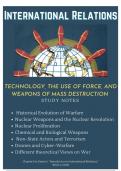, Technology has shaped warfare over the centuries, though change in the past was generally slow.
Universal conscription, the telegraph, the machine gun, and the blitzkrieg all represent new tactics or
technologies that shifted the way war was fought.
Nuclear weapons, first developed by the United States during World War II in a secret project
codenamed the Manhattan Project, reshaped both warfare and international relations to an enormous
degree.On July 16, 1945, the United States detonated a very different type of bomb at a remote testing
site near Alamogordo, New Mexico. That device – by today’s standards, a very simple and crude
nuclear bomb – released the energy equivalent of 19,000 tons of TNT. The explosion in the New
Mexican desert, which American nuclear scientists labeled the Trinity test, ushered in a new era for
military technology and international politics
- The Trinity test was the culmination of a secret project that began just as America entered
World War II. Codenamed the Manhattan Project, it brought together some of the best scientific
minds of the United States and Europe to develop a super-weapon that would take advantage of
recent discoveries in atomic physics.
On August 6, 1945, a US Air Force B-29 plane dropped a nuclear weapon called Little Boy on the
Japanese city of Hiroshima. Three days later, a second bomb known as Fat Man was detonated over
Nagasaki. The destructive effects were startling. The Hiroshima bomb killed between 70,000 and
80,000 people and injured 70,000 others. The Nagasaki bomb exploded over a relatively isolated part
of the city, resulting in about 40,000 killed and 40,000 injured. Japan surrendered shortly after the
nuclear attacks on Hiroshima and Nagasaki, effectively ending World War II.
In 1949, the Soviet Union shocked the world by successfully testing its own version of a fission atomic
bomb. By 1952, the United States had developed an even more powerful and sophisticated device – a
thermonuclear, or fusion bomb
Blast effect
The immediate explosive effect of a nuclear weapon. Can be powerful enough to level all buildings in a
several-mile radius and to produce destructive winds of between 100 and 200 miles per hour.
Thermal effect
The secondary effect of a nuclear explosion, in which the heat waves from the explosion can cause
third-degree burns up to five miles from the detonation site.
Fallout effect
The tertiary effect of a nuclear explosion. Because nuclear weapons cause dirt and air particles to
become radioactive, an explosion can expose people hundreds of miles from the blast site to fatal
cancers over time. This exposure to radiation is the fallout effect, and affects a much wider range than
the blast or thermal effects.
Nuclear deterrence
Using the threat of retaliation to protect oneself from an attack. Nuclear states use the threat of
nuclear retaliation to deter other states from attacking them.
Extended deterrence
The threat by one country to use its nuclear forces to protect other countries.
Chemical weapons use manufactured chemicals to kill people. Common examples include chlorine
gas and mustard gas, both of which were used by combatants in World War I. These chemicals do their
damage by blistering lung tissue




